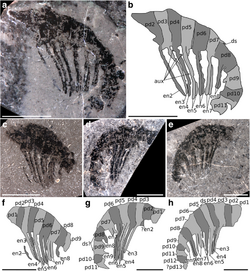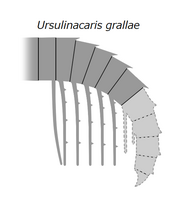Biology:Ursulinacaris
| Ursulinacaris | |
|---|---|

| |
| Appendages from the Mount Cap Formation | |
| Scientific classification | |
| Domain: | Eukaryota |
| Kingdom: | Animalia |
| Phylum: | Arthropoda |
| Class: | †Dinocaridida |
| Order: | †Radiodonta |
| Family: | †Hurdiidae |
| Genus: | †Ursulinacaris |
| Species: | †U. grallae
|
| Binomial name | |
| †Ursulinacaris grallae Pates et al. 2019
| |
Ursulinacaris is a genus of hurdiid radiodont from the Cambrian of North America. It contains one known species, Ursulinacaris grallae. It was described in 2019, based on fossils of the frontal appendages discovered in the 1990s and thereafter. The endites of Ursulinacaris were very slender, unlike other hurdiids such as Peytoia or Hurdia.[1] It was initially reported as the first hurdiid with paired endites (a feature only present in other non-hurdiid radiodonts), but Moysiuk & Caron (2021) suggested that it is actually the preservation of the fossils and thus no paired endites.[2][3]
Discovery and naming
Ursulinacaris fossils have been found in the Northwest Territories and Nevada. Most specimens come from the Little Bear biota of the Mount Cap Formation, though one referred specimen is from the Jangle Limestone member of the Carrara Formation of Nevada. Its generic name refers to the Little Bear biota, being derived from Latin "ursulina" meaning "from little bear" and "caris" meaning "crab". The name of the type species, U. grallae, is derived from the Latin word "grallae," which means "stilts," as a reference to the shape of the spines.[1]
Gallery
References
- ↑ 1.0 1.1 Pates, Stephen; Daley, Allison C.; Butterfield, Nicholas J. (2019-06-11). "First report of paired ventral endites in a hurdiid radiodont" (in en). Zoological Letters 5 (1): 18. doi:10.1186/s40851-019-0132-4. ISSN 2056-306X. PMID 31210962.
- ↑ Moysiuk, Joseph; Caron, Jean-Bernard (2021). "Exceptional multifunctionality in the feeding apparatus of a mid-Cambrian radiodont" (in en). Paleobiology 47 (4): 704–724. doi:10.1017/pab.2021.19. ISSN 0094-8373. https://www.cambridge.org/core/journals/paleobiology/article/exceptional-multifunctionality-in-the-feeding-apparatus-of-a-midcambrian-radiodont/CF717CA7C758CEAEF29AD6301BE2C4DC.
- ↑ Potin, Gaëtan J.-M.; Daley, Allison C. (2023). "The significance of Anomalocaris and other Radiodonta for understanding paleoecology and evolution during the Cambrian explosion". Frontiers in Earth Science 11. doi:10.3389/feart.2023.1160285/full. ISSN 2296-6463. https://www.frontiersin.org/articles/10.3389/feart.2023.1160285.
Wikidata ☰ {{{from}}} entry



